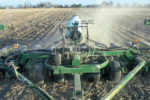Advertise Follow Us
Items Tagged with 'cropping'
ARTICLES
Extend Your Cropping Boundaries
With no heavy tillage equipment to move, this father and son are cropping land 210 miles away from their home base.
Read More
No-Till Notes
Sharpen Your Pencil Under Today’s Volatile Economics
It’s a good time to evaluate land, machinery, labor, grain storage and marketing as part of a yearly cropping systems budget review.
Read More
Pinpoint Your Spray Control
Better placement, cost savings identified with map-based individual spray-control nozzle systems.
Read More
Innovators Help Spread the Latest No-Till Knowledge
The 11th class of No-Till Innovators has made significant contributions to expanding the acceptance of no-till in the U.S.
Read More
What I've Learned from No-Tilling
Teaching And Studying Bring New Insights Into The New-Till World
Finding how no-tilling and organic agricultural practices can benefit one another is just one area that deserves a closer look.
Read More
Local No-Tillers Join To Create Research Farm
With funding from a variety of sponsors, they can investigate the practices that work well in their immediate area and prepare for the future with confidence.
Read More









